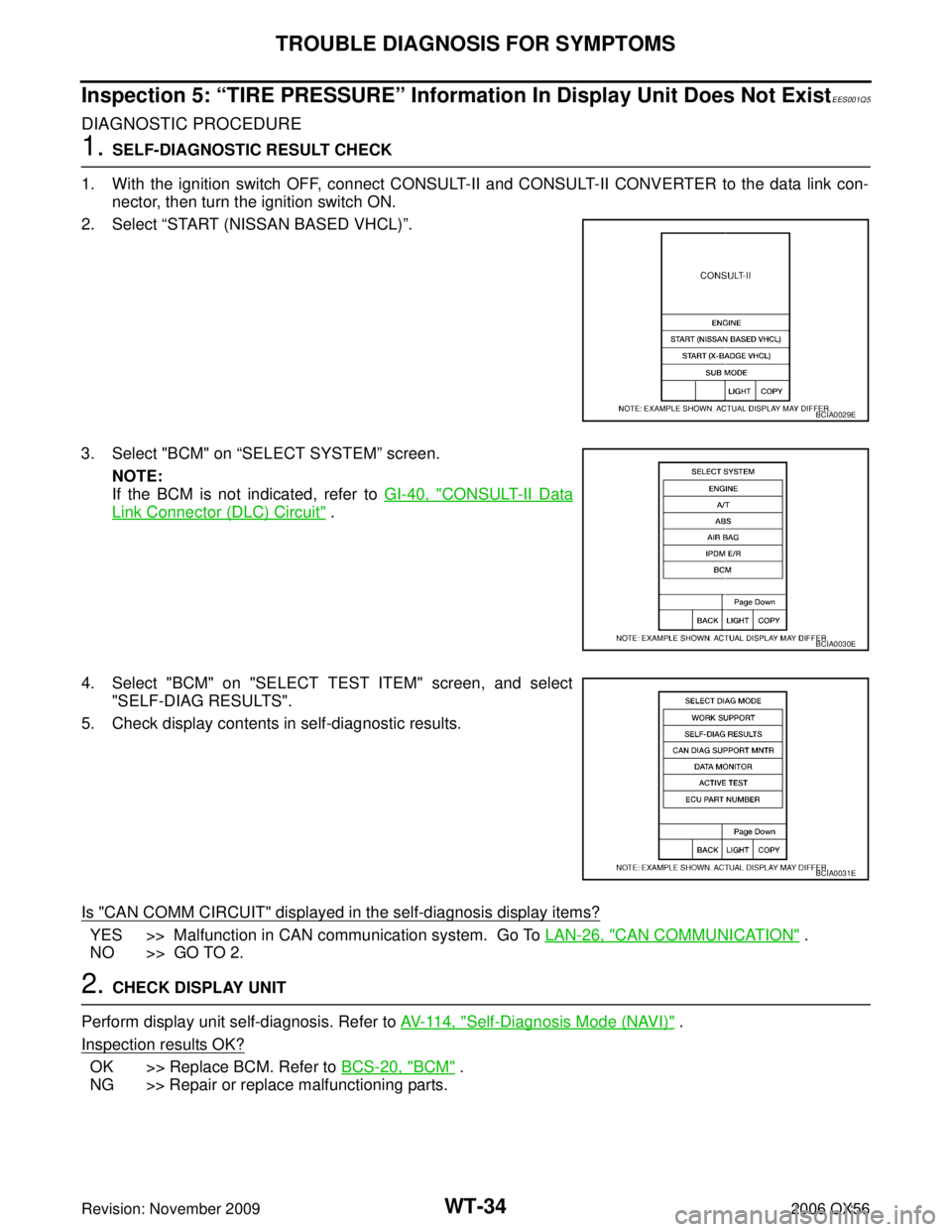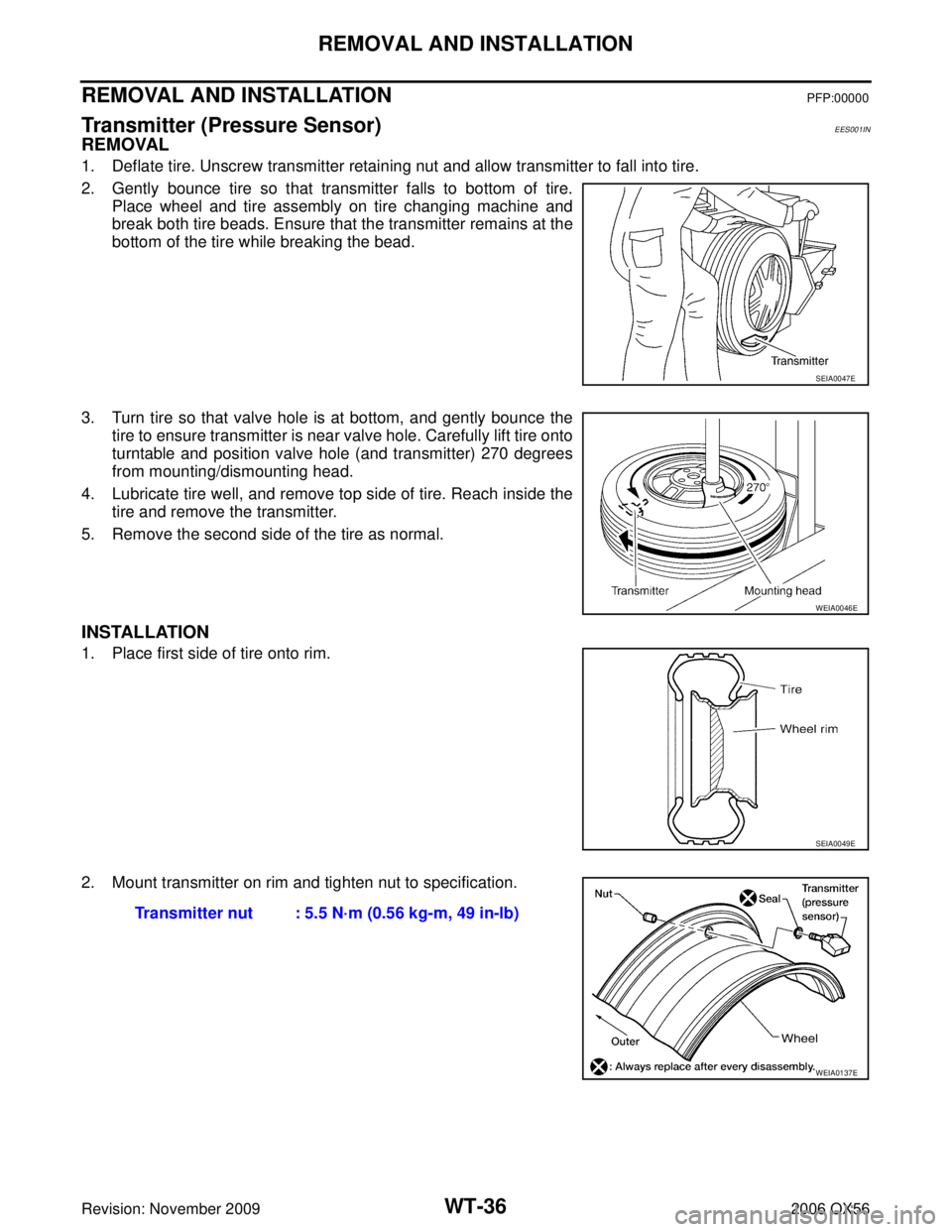Page 3321 of 3383
WT-32
TROUBLE DIAGNOSIS FOR SYMPTOMS
Revision: November 20092006 QX56
Inspection 3: Warning Lamp Flashes When Ignition Switch Is Turned OnEES001IJ
NOTE:
If warning lamp flashes as shown, the system is normal.
Flash Mode A
�This mode shows transmitter status is OFF-mode.
Carry out transmitter wake up operation. Refer to WT-18,
"Transmitter Wake Up Operation" .
DIAGNOSTIC PROCEDURE
1. CHECK CONNECTOR
1. Turn ignition switch OFF.
2. Disconnect BCM harness connectors M18 and M20.
3. Check terminals for damage or loose connections.
Inspection results OK?
OK >> GO TO 2.
NG >> Repair or replace damaged parts.
2. CHECK TIRE PRESSURE WARNING CHECK CONNECTOR CIRCUIT
Check continuity between BCM connector M18 terminal 15 and tire pressure warning check connector M123
terminal 1.
OK or NG
OK >> Replace BCM. Refer to BCS-20, "BCM" .
NG >> Repair or replace harness connector.
SEIA0347E
1 - 15 Continuity should exist
WEIA0097E
Page 3323 of 3383

WT-34
TROUBLE DIAGNOSIS FOR SYMPTOMS
Revision: November 20092006 QX56
Inspection 5: “TIRE PRESSURE” Information In Display Unit Does Not ExistEES001Q5
DIAGNOSTIC PROCEDURE
1. SELF-DIAGNOSTIC RESULT CHECK
1. With the ignition switch OFF, connect CONSULT-II and CONSULT-II CONVERTER to the data link con- nector, then turn the ignition switch ON.
2. Select “START (NISSAN BASED VHCL) ”.
3. Select "BCM" on “SELECT SYSTEM” screen.
NOTE:
If the BCM is not indicated, refer to GI-40, "
CONSULT-II Data
Link Connector (DLC) Circuit" .
4. Select "BCM" on "SELECT TEST ITEM" screen, and select "SELF-DIAG RESULTS".
5. Check display contents in self-diagnostic results.
Is "CAN COMM CIRCUIT" displayed in the self-diagnosis display items?
YES >> Malfunction in CAN communication system. Go To LAN-26, "CAN COMMUNICATION" .
NO >> GO TO 2.
2. CHECK DISPLAY UNIT
Perform display unit self-diagnosis. Refer to AV- 11 4 , "
Self-Diagnosis Mode (NAVI)" .
Inspection results OK?
OK >> Replace BCM. Refer to BCS-20, "BCM" .
NG >> Repair or replace malfunctioning parts.
BCIA0029E
BCIA0030E
BCIA0031E
Page 3325 of 3383

WT-36
REMOVAL AND INSTALLATION
Revision: November 20092006 QX56
REMOVAL AND INSTALLATIONPFP:00000
Transmitter (Pressure Sensor)EES001IN
REMOVAL
1. Deflate tire. Unscrew transmitter retaining nut and allow transmitter to fall into tire.
2. Gently bounce tire so that transmitter falls to bottom of tire.
Place wheel and tire assembly on tire changing machine and
break both tire beads. Ensure that the transmitter remains at the
bottom of the tire while breaking the bead.
3. Turn tire so that valve hole is at bottom, and gently bounce the tire to ensure transmitter is near valve hole. Carefully lift tire onto
turntable and position valve hole (and transmitter) 270 degrees
from mounting/dismounting head.
4. Lubricate tire well, and remove top side of tire. Reach inside the tire and remove the transmitter.
5. Remove the second side of the tire as normal.
INSTALLATION
1. Place first side of tire onto rim.
2. Mount transmitter on rim and tighten nut to specification.
SEIA0047E
WEIA0046E
SEIA0049E
Transmitter nut : 5.5 N·m (0.56 kg-m, 49 in-lb)
WEIA0137E
Page 3327 of 3383
WT-38
SERVICE DATA AND SPECIFICATIONS (SDS)
Revision: November 20092006 QX56
SERVICE DATA AND SPECIFICATIONS (SDS)PFP:00030
Road WheelEES001IO
TireEES001IP
Unit: kPa (kg/cm2 , psi)
Wheel type
Aluminum
Maximum radial runout limit Lateral mm (in)
0.3 (0.012) or less
Radial mm (in) 0.3 (0.012) or less
Maximum residual imbalance Dynamic (at rim flange)
Less than 5 g (0.18 oz) (per side)
Static (at rim flange) Less than 10 g (0.35 oz)
Tire size Air pressure
Conventional tire Spare tire
Full size spare tire —240 (2.4, 35)
P265/70R18 240 (2.4, 35)—